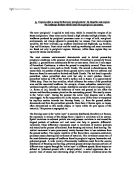Attrition
The process it which rocks already eroded from the cliffs, causing abrasion, are slowly worn down into smaller and more rounded particles.
Solution (corrosion)
Mainly the erosion of calcium based rock, such as limestone. Limestone can be dissolved by carbonic acid present in sea water. The evaporation of salts from water in the rocks produces crystals, these expand as they form, causing the rock to weaken and disintegrate.
Transportational Processes
Long-Shore Drift
Most waves move toward the shore at a slight angle.
Consequently the swash and backwash of the waves come off at different angles; therefore we can expect and show that sediment moved up the beach by the swash will be brought back down by the backwash at a different angle, consequently further down the beach.
This results in a zigzag migration of sediment along the beach by the processes of Saltation and Traction called long shore drift.
Solution
Limestone dissolved by carbonic acid in the seawater will me moved depending on where the wave travels to.
Suspension
Small particles of sand etc are carried along within the flow of the moving water. The material is likely to be the largest proportion of the sediment picked up by a breaking wave.
Traction & Saltation
Larger particles which cannot be picked up by the wave may be moved along the beach/sea bed by one of two ways. Saltation occurs when smaller particles are temporarily picked up and bounced along the bed in a hopping motion.
Traction occurs when the largest rocks and boulders roll or slide along the bed.
Influences on Coastal Erosion







